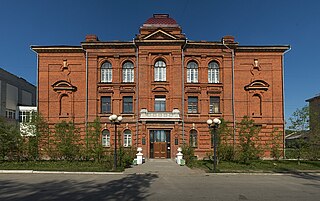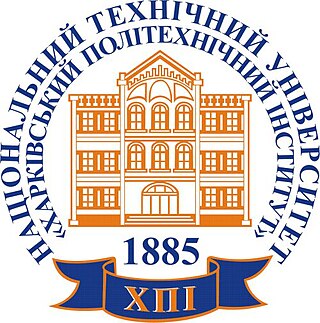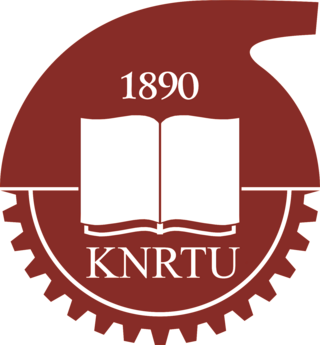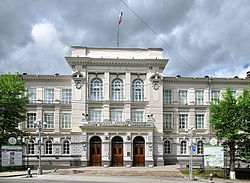
The National Research Tomsk State University, TSU is a public research university located in Tomsk, Russia. The university, which opened in 1888, was the first university in the Asian part of Russia and, in practice, the first Russian university East of the Volga.

Kazan Federal University is a public research university located in Kazan, Russia.

The Bauman Moscow State Technical University, sometimes colloquially referred as the Bauman School or Baumanka (Бауманка), is a public technical university (polytechnic) located in Moscow, Russia. Bauman University offers B.S., M.S & PhD degrees in various engineering fields and applied sciences. In 2023, US News & World Report ranked it #1,758 in the world.

The Polytechnic University of Turin is the oldest Italian public technical university. The university offers several courses in the fields of Engineering, Architecture, Urban Planning and Industrial Design, and is consistently ranked as one of the best universities in Italy and in Europe. As of 2023, it is ranked( QS World University Rankings ) 26th worldwide for Mechanical Engineering, 15th for Petroleum Engineering, 28th for Architecture and is among the top 50 (#45th) engineering universities in the world.

Graz University of Technology is a public research university located in Styria, Austria. It was founded in 1811 by Archduke John of Austria and is the oldest science and technology research and educational institute in Austria. It currently comprises seven faculties and is a public university. It offers 19 bachelor's and 35 master's study programmes across all technology and natural sciences disciplines. Doctoral training is organised in 14 English-speaking doctoral schools. The university has more than 16,000 students, and around 1,800 students graduate every year. The Graz University of Technology and the University of Graz co-operate in teaching and research of natural sciences.

Politehnica University of Bucharest is a technical university in Bucharest, Romania. 200 years of activity have been celebrated lately, as the university was founded in 1818. Politehnica University is classified by the Ministry of Education as an advanced research and education university.

The Tomsk State University of Architecture and Building is located in Tomsk, Russia in Western Siberia. TSUAB provides fundamental and applied training of students within bachelor, master and specialist programs in architecture and civil engineering.

Tomsk State University of Control Systems and Radioelectronics is a public university in Tomsk, Russia. Founded in 1962, TUSUR University was formed when two faculties, the Faculty of Radio Engineering and the Faculty of Electric Radio Control, split from Tomsk Polytechnic University to create a new educational institution.

Peter the Great St. Petersburg Polytechnic University, abbreviated as SPbPU, is a public technical university located in Saint Petersburg, Russia. The university houses one of the country's most advanced research labs in hydro–aerodynamics. The university's alumni include Nobel Prize winners, such as Pyotr Kapitsa and Zhores Alferov, physicists and atomic weapon designers such as Yulii Khariton, Nikolay Dukhov, Abram Ioffe, Aleksandr Leipunskii, and Yakov Zeldovich, aircraft designers and aerospace engineers, such as Yulii Khariton, Oleg Antonov, Nikolai Polikarpov, and Georgy Beriev, and chess grandmasters, such as David Bronstein. The university offers academic programs at the Bachelor, Master's, and Doctorate degree levels. SPbSPU consists of structural units called Institutes divided into three categories: Engineering Institutes, Physical Institutes, and Economics and Humanities Institutes. In 2022, the university was ranked #301 in the world in the Times Higher Education (THE) World University Rankings, #393 in QS World University Rankings, #679 in Best Global Universities Rankings by U.S. News & World Report, and #1,005 by Center for World University Rankings.

The National Technical University "Kharkiv Polytechnic Institute", in the city of Kharkiv, is the largest and oldest technical university in eastern Ukraine. Founded in 1885, it is the second-oldest technical university in the former Russian Empire modern Ukraine territory.

MIREA — Russian Technological University is The Federal State Budget Educational Institution of Higher Education «MIREA — Russian Technological University». It is a higher educational institution in Moscow, Russia, which is an educational, research and innovation complex. It was ranked # 1,960 globally in 2023 by US News & World Report.

State University "Kyiv Aviation Institute" is a university located in Kyiv, Ukraine. It started in 1933 when the Kyiv Aviation Institute was founded on the basis of the mechanical department of Kyiv Machine-Building Institute. The university consists of five institutes, ten separate faculties, two lyceums, six colleges and Military Training Department. The university has its own Culture and Arts Center, Aviation Medical Center, Flight Training Center, Training and Sports Wellness Center,Scientific and Technical Library, “Aviator” newspaper and a yacht club. The university also supports the State Aviation Museum.

Kazan National Research Technological University, KNRTU is an innovational scientific educational complex. The University comprises 15 academic and research institutes; runs over 100 Specialist, Bachelor's, Master's Degree and Ph.D. programs; enrolls over 27,000 undergraduate and graduate students, 900 Ph.D. and 100 Post-Doc students from Russia and other countries; employs over 300 Full Professors, Doctors of Science and 800 Associate Professors, Ph.D.s; raises the budget of 1.4 billion rubles.

Ural Federal University, named after the first President of Russia, B. N. Yeltsin, is an educational institution in the Ural region of Russia. The Ural Federal University was formed by a merger of the Ural State Technical University and Ural State University. It is one of 10 Russian Federal Universities. The university cooperates with the Russian Academy of Sciences and serves as a research and innovation center for the Ural region. UrFU offers educational programs in four areas of knowledge and 108 academic majors.

Petr Savelyevich Chubik – Since 2008 Rector of Tomsk Polytechnic University. He is a specialist in drilling cleaning fluids. Vice-president of the Association for Engineering Education of Russia, Vice-President of the Association of Technical Universities, Chairman of the Association "Tomsk consortium of scientific, educational and research institutions", member of the International Academy of Science of Higher Education and the Russian Academy of Russian Engineering. Co-Chair of the Board of the Association Consortium of supporting universities of the State Corporation "Rosatom", a member of the Board of the Association of the leading universities of Russia, member of the advisory council to the deputy governor of Tomsk region on scientific, educational complex and innovation policy. Member of the party "United Russia".

Project 5-100 was a special government run program to develop major Russian universities. The program was launched by the Russian Ministry of Education and Science in 2013. It was aimed at improving the prestige of Russian higher education and bring at least five universities from among the project participants into the 100 best universities in the world according to the three most authoritative world rankings: Academic Ranking of World Universities (ARWU), Times Higher Education (THE), and Quacquarelli Symonds (QS) by 2020. However, this goal was never achieved.

Moscow State University of Civil Engineering or MGSU is a higher education institution located in Moscow, Russia. It is located on Yaroslavl Highway in Yaroslavsky district.

Nikolai Viktorovich Kultashev was a Russian and Soviet chemist, Doctor of Chemical Sciences, Rector (1918–1919), Dean of the Faculty of Physics and Mathematics (1917–1919) of Perm State University, Professor of Tomsk and Voronezh Universities.

Ivanovo State Power Engineering University is a higher education institution in the city of Ivanovo, founded on 24 June 1930 on the basis of the mechanical engineering faculty of the Ivanovo-Voznesensk Polytechnic Institute. Until 1992, it was called the Ivanovo Power Engineering Institute. V. I. Lenin.



































